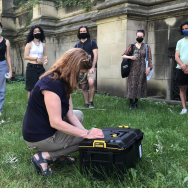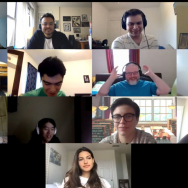Editor’s Note: This is part of a series called UChicago Class Visits, spotlighting transformative classroom experiences and unique learning opportunities offered at UChicago.
If you want to measure cosmic rays, you can’t stop by the hardware store and pick up a detector on your way home. You have to make the device yourself.
Scientists have been devising their own machines for centuries—from Dutchmen in the 1600s inventing the microscope, all the way to the modern particle accelerators that span several miles. A new class at the University of Chicago is inviting students to follow in these footsteps, learning how to design, build and calibrate their own devices. Called “Creative Machines and Innovative Instruments,” the class has students writing code, 3D printing their designs and learning the challenges of making something entirely new from scratch.
“We had them designing and building in the very first week,” said Prof. Emeritus Stephan Meyer, who is co-teaching the class. “It’s been great fun. There’s just a tremendous amount of energy in the class.”
The University of Chicago has a long tradition of building one-of-a-kind machines for science: Instruments built here have flown around the Earth’s poles, surveyed the oldest light in the universe, roved the surface of Mars, and explored Saturn’s rings. But there has never been a formal class devoted to the subject.
This fall quarter, however, marked the start of a new curriculum. The inaugural class, which includes 16 students, is the first in a series that Meyer and a group of fellow physicists and astronomers have planned for years.
“What we hope is that students will take away an overview of the entire design process—what it takes to move from concept to reality,” said Prof. Scott Wakely, who is co-teaching the class this quarter.
Meyer and Wakely know what they’re talking about; they are experimental physicists, specializing in building one-of-a-kind instruments for science. Both have designed instruments for decades, including machines to map the cosmic background radiation of the universe, to track the paths of cosmic rays through the atmosphere, and even to look for “holographic noise” in the universe.
“Making an instrument is both incredibly rewarding and incredibly frustrating at times, and this gives students a way to experience both firsthand,” Wakely said.
Meyer agreed: “I’ve been really impressed with their persistence and willingness to try again.”
In the first week of the course, students used a common design program to create their own models—first a coffee cup, and then a small car powered by a rubber band. Then they 3D printed each car, and raced them to see which went the farthest. Next, they incorporated electronics, modifying the cars to use a tiny motor controlled by a computer chip and a sensor—with the ultimate goal of designing a car that steers itself away from walls or obstacles.
“Controlling the device, giving it a way to sense its surroundings, and then programming to decide what to do with that information—that’s really the three essential parts of virtually anything you’re going to build,” said Meyer.
In the real world, Meyer added, each design step requires making numerous decisions. For example, as the students consider how to design a car that avoids hitting things as it moves, they know it will need some kind of measuring device to detect obstacles. Some students chose light beam sensors, others ultrasonic sensors, and one team even whiskers, like a cat. “Each option has its advantages and disadvantages, and in engineering, these must be considered against things like weight, cost and development time. This class exposes students to those kind of problems,” Meyer said.
In between the laboratory work, there are lectures on the basics of programming, design and electronics, as well as guest lectures from professionals currently working in the field such as Benjamin Stillwell, a research engineer who works with UChicago scientists to develop their scientific instruments.
The initial course offerings will guide the students through the design and execution process; they envision later offerings specializing in electronics and even project management.
“I love this class. There’s a little bit of everything,” said Hanjue Zhu, an astrophysics graduate student.
“In a lot of other UChicago courses, you’re learning theory,” said second-year undergraduate Todd Tan, “but then in this class, we make it real.”
Ultimately, the professors hope the course will prepare students for careers in virtually any field. Some of the students are from physics and astrophysics tracks, but others come from neuroscience, computer sciences, chemistry, mathematics and art.
“Understanding the basics of engineering and how to use power tools opened a lot of doors for me,” said Wakely. “I hope it will for them, too.”

